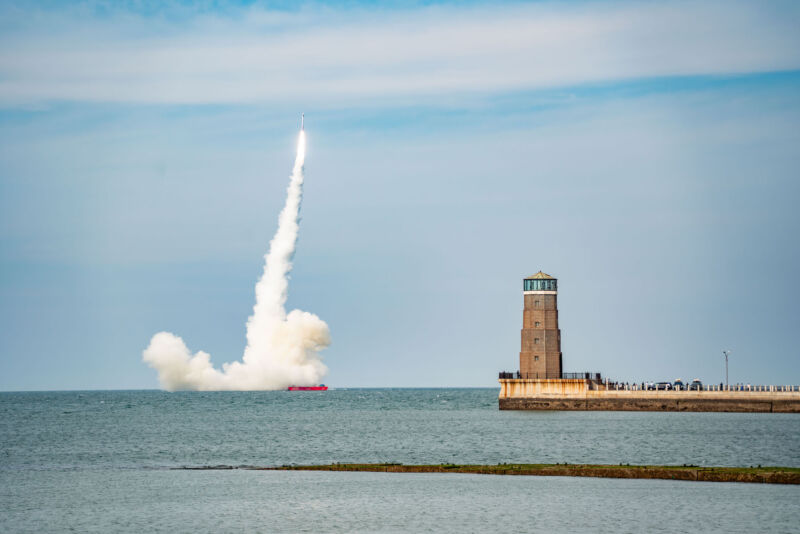
Enlarge / A sea-borne variant of the commercial Ceres 1 rocket lifts off near the coast of Rizhao, a city of 3 million in China’s Shandong province.
Welcome to Edition 6.46 of the Rocket Report! It looks like we will be covering the crew test flight of Boeing’s Starliner spacecraft and the fourth test flight of SpaceX’s giant Starship rocket over the next week. All of this is happening as SpaceX keeps up its cadence of flying multiple Starlink missions per week. The real stars are the Ars copy editors helping make sure our stories don’t use the wrong names.
As always, we welcome reader submissions, and if you don’t want to miss an issue, please subscribe using the box below (the form will not appear on AMP-enabled versions of the site). Each report will include information on small-, medium-, and heavy-lift rockets as well as a quick look ahead at the next three launches on the calendar.

Another North Korean launch failure. North Korea’s latest attempt to launch a rocket with a military reconnaissance satellite ended in failure due to the midair explosion of the rocket during the first-stage flight this week, South Korea’s Yonhap News Agency reports. Video captured by the Japanese news organization NHK appears to show the North Korean rocket disappearing in a fireball shortly after liftoff Monday night from a launch pad on the country’s northwest coast. North Korean officials acknowledged the launch failure and said the rocket was carrying a small reconnaissance satellite named Malligyong-1-1.
Russia’s role? … Experts initially thought the pending North Korean launch, which was known ahead of time from international airspace warning notices, would use the same Chŏllima 1 rocket used on three flights last year. But North Korean statements following the launch Monday indicated the rocket used a new propulsion system burning a petroleum-based fuel, presumably kerosene, with liquid oxygen as the oxidizer. The Chŏllima 1 rocket design used a toxic mixture of hypergolic hydrazine and nitrogen tetroxide as propellants. If North Korea’s statement is true, this would be a notable leap in the country’s rocket technology and begs the question of whether Russia played a significant role in the launch. Last year, Russian President Vladimir Putin pledged more Russian support for North Korea’s rocket program in a meeting with North Korean leader Kim Jong Un. (submitted by Ken the Bin and Jay500001)
Rocket Lab deploys small NASA climate satellite. Rocket Lab is in the midst of back-to-back launches for NASA, carrying identical climate research satellites into different orbits to study heat loss to space in Earth’s polar regions. The Polar Radiant Energy in the Far-InfraRed Experiment (PREFIRE) satellites are each about the size of a shoebox, and NASA says data from PREFIRE will improve computer models that researchers use to predict how Earth’s ice, seas, and weather will change in a warming world. “The difference between the amount of heat Earth absorbs at the tropics and that radiated out from the Arctic and Antarctic is a key influence on the planet’s temperature, helping to drive dynamic systems of climate and weather,” NASA said in a statement.
Twice in a week… NASA selected Rocket Lab’s Electron launch vehicle to deliver the two PREFIRE satellites into orbit on two dedicated rides rather than launching at a lower cost on a rideshare mission. This is because scientists want the satellites flying at the proper alignment to ensure they fly over the poles several hours apart, providing the data needed to measure how the rate at which heat radiates from the polar regions changes over time. The first PREFIRE launch occurred on May 25, and the next one is slated for May 31. Both launches will take off from Rocket Lab’s base in New Zealand. (submitted by Ken the Bin)
The easiest way to keep up with Eric Berger’s space reporting is to sign up for his newsletter, we’ll collect his stories in your inbox.
A rocket launch comes to Rizhao. China has diversified its launch sector over the last decade to include new families of small satellite launchers and new spaceports. One of these relatively new small rockets, the solid-fueled Ceres 1, took off Wednesday from a floating launch pad positioned about 2 miles (3 km) off the coast of Rizhao, a city of roughly 3 million people in China’s Shandong province. The Ceres 1 rocket, developed by a quasi-commercial company called Galactic Energy, has previously flown from land-based launch pads and a sea-borne platform, but this mission originated from a location remarkably close to shore, with the skyline of a major metropolitan area as a backdrop.
Range safety … There’s no obvious orbital mechanics reason to position the rocket’s floating launch platform so near a major Chinese city, other than perhaps to gain a logistical advantage by launching close to port. The Ceres 1 rocket has a fairly good reliability record—11 successes in 12 flights—but for safety reasons, there’s no Western spaceport that would allow members of the public (not to mention a few million) to get so close to a rocket launch. For decades, Chinese rockets have routinely dropped rocket boosters containing toxic propellant on farms and villages downrange from the country’s inland spaceports.